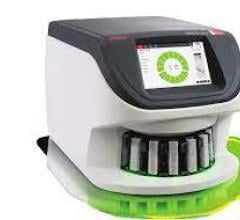
June 29, 2022 — Bayer unveiled Calantic Digital Solutions, a new cloud-hosted platform delivering access to digital applications, including AI-enabled programs, for medical imaging. The offering contains tools to help triage critical patient findings for expedited review, improve lesion detection and automate tasks. With this launch, Bayer expands its radiology portfolio beyond contrast media, devices, software and services, with the ultimate goal of supporting healthcare professionals to aid in the detection of disease patterns throughout the patient’s journey.
The launch comes at a time when chronic diseases are on the rise, increasing the demand for medical imaging. With radiology’s increasing complexity, including a five-fold jump in the number of magnetic resonance imaging (MRI) images produced per scan, to meet workload demands, an average radiologist in some cases would need to interpret one image every 3-4 seconds in an 8-hour workday.1-Exacerbating this situation is a shortage of radiologists. 2-Time pressure and workload contribute to the prevalence of burn-out among radiologists. 3-In addition, data show the rate of diagnostic errors rises with long hours of overtime. 4-Digital technologies can help manage the mounting workload of radiologists and their teams, ultimately striving to improve patient care.
“AI has the potential to transform healthcare, and, particularly in medical imaging, it can turn the growing amounts of data into value-adding insights to support radiologists and their teams in their decision-making,” says Dr. Ryan Lee, Chair, Department of Radiology, Einstein Healthcare Network, Philadelphia. “It is crucial to drive innovation in this area and broaden access to digital tools that can help address the rising demand for solutions which improve the speed and accuracy of diagnoses.”
The apps will be centered around three key areas to help manage efficiencies across the radiology workflow: triage apps to flag suspected pathologies and findings that warrant urgent review and treatment; detection apps to improve lesion detection; and quantification apps for automation of routine tasks.
“Built on our leading industry knowledge and deep medical understanding across a multitude of diagnostic and therapeutic areas, Calantic Digital Solutions underlines our commitment to continue accelerating innovation for the benefit of patients and their physicians,” says Gerd Krüger, Head of Radiology, Bayer Pharmaceuticals. “With Calantic Digital Solutions, we are entering the fastest growing segment in the radiology market and taking the next step from a product provider to a solution provider, following our mission to provide an ecosystem of third-party and Bayer products to deliver innovative disease-oriented solutions for radiologists and their teams.”
About Calantic Digital Solutions
Calantic Digital Solutions is a suite of digital radiology AI-enabled applications which assist radiologists and their teams at critical steps within a patient’s treatment journey. The vendor-neutral, cloud-based platform includes a growing number of applications designed to aid in prioritization, lesion detection, and quantification, as well as apps that automate routine tasks and measurements, improve the radiology suites’ workflow, and potentially free up time for radiologists and their teams. The offering is orchestrated by body region and diagnostic procedure, initially focusing on thoracic and neurological diseases, such as pulmonary nodule detection and triage of suspected intracerebral hemorrhage and large vessel occlusions. More disease-specific application packages will be added moving forward. Bayer provides services around installation, configuration, and training of the platform and its applications. First launch markets to include the US and several European countries, with more regions to follow, upon local regulatory approvals as applicable.
About AI in Medical Imaging
The radiology AI market is growing dynamically, with an estimated compound annual growth rate (CAGR) of more than 25 percent through 2025.1 Innovation powered by AI is more needed than ever: aging populations and changing lifestyles are leading to an increase in chronic conditions such as cardiovascular disease and cancer.5,6 Consequently, the demand for medical imaging to detect diseases, guide treatment decisions and support therapy planning is growing.
For more information: www.bayer.com
Find more information on AHRA22
References:
1 McDonald RJ, Schwartz KM, Eckel LJ, et al. The effects of changes in utilization and technological advancements of cross-sectional imaging on radiologist workload. Acad Radiol. 2015 Sep;22(9):1191-8. doi: 10.1016/j.acra.2015.05.007. Epub 2015 Jul 22. PMID: 26210525.
2 The Complexities of Physician Supply and Demand: Projections From 2018 to 2033. Association of American Medical Colleges. June 2020. Available at: https://www.aamc.org/media/45976/download.
3 Chetlen AL, Chan TL, Ballard DH, et al. Addressing Burnout in Radiologists. Acad Radiol. 2019 Apr;26(4):526-533. doi: 10.1016/j.acra.2018.07.001. Epub 2018 Jul 31. PMID: 30711406; PMCID: PMC6530597.
4 Cannon CL, Beechman JF, DeQuesada I, et al. Physician Burnout in Radiology: Perspectives From the Field. American Journal of Roentgenology. 2022;218: 370-374. 10.2214/AJR.21.26756
5 Roth GA, Mensah GA, Johnson CO, et al. Global Burden of Cardiovascular Diseases and Risk Factors, 1990–2019: Update From the GBD 2019 Study. J Am Coll Cardiol. 2020 Dec, 76 (25) 2982–3021.
6 Sung H, Ferlay J, Siegal R, et al. Global Cancer Statistics 2020: GLOBOCAN Estimates of Incidence and Mortality Worldwide for 36 Cancers in 185 Countries. CA: A Cancer Journal for Clinicians 2021;71:209-249


 May 02, 2024
May 02, 2024 








